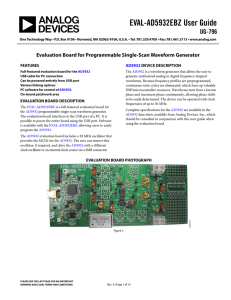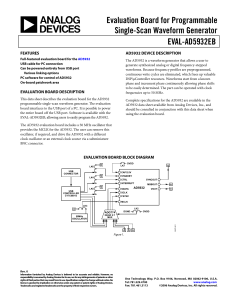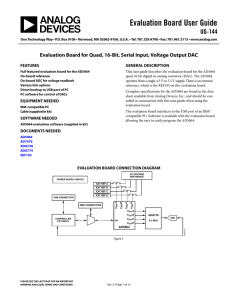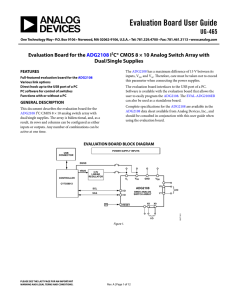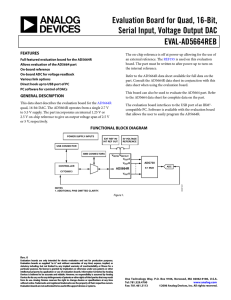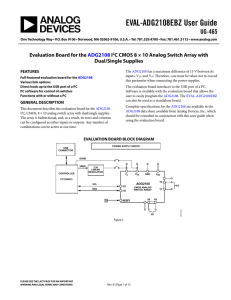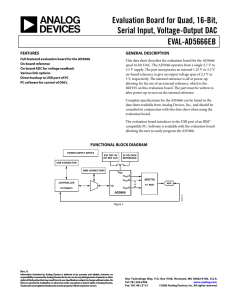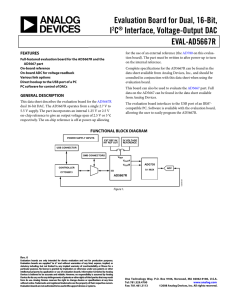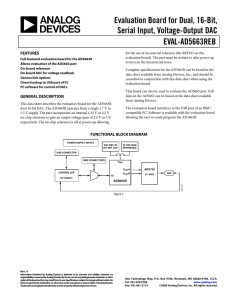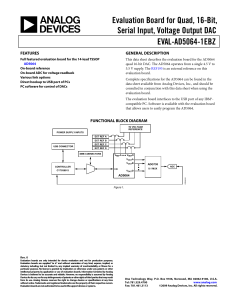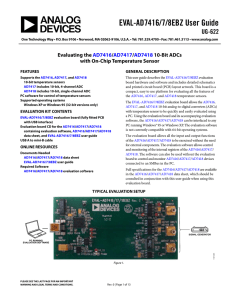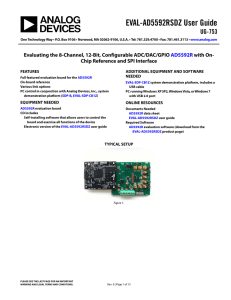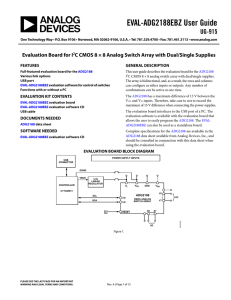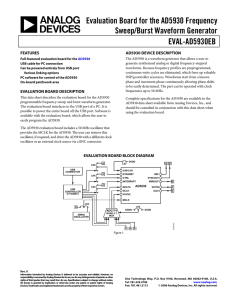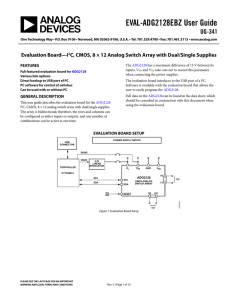EVAL-AD5930EBZ User Guide UG-822
advertisement
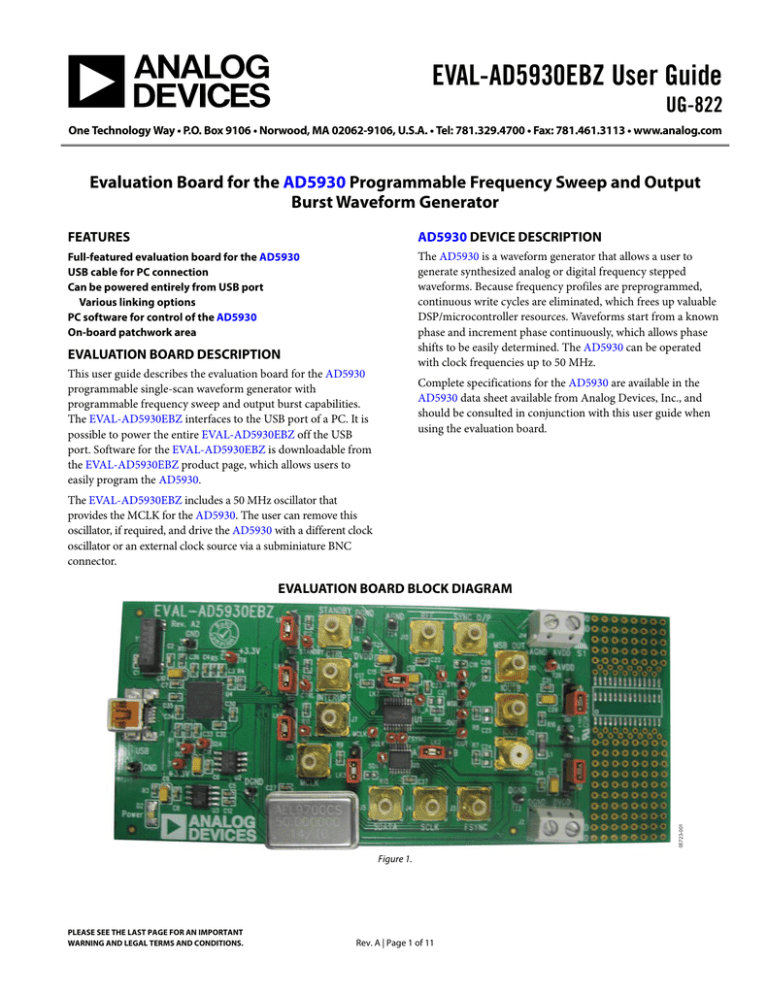
EVAL-AD5930EBZ User Guide UG-822 One Technology Way • P.O. Box 9106 • Norwood, MA 02062-9106, U.S.A. • Tel: 781.329.4700 • Fax: 781.461.3113 • www.analog.com Evaluation Board for the AD5930 Programmable Frequency Sweep and Output Burst Waveform Generator FEATURES AD5930 DEVICE DESCRIPTION Full-featured evaluation board for the AD5930 USB cable for PC connection Can be powered entirely from USB port Various linking options PC software for control of the AD5930 On-board patchwork area The AD5930 is a waveform generator that allows a user to generate synthesized analog or digital frequency stepped waveforms. Because frequency profiles are preprogrammed, continuous write cycles are eliminated, which frees up valuable DSP/microcontroller resources. Waveforms start from a known phase and increment phase continuously, which allows phase shifts to be easily determined. The AD5930 can be operated with clock frequencies up to 50 MHz. EVALUATION BOARD DESCRIPTION This user guide describes the evaluation board for the AD5930 programmable single-scan waveform generator with programmable frequency sweep and output burst capabilities. The EVAL-AD5930EBZ interfaces to the USB port of a PC. It is possible to power the entire EVAL-AD5930EBZ off the USB port. Software for the EVAL-AD5930EBZ is downloadable from the EVAL-AD5930EBZ product page, which allows users to easily program the AD5930. Complete specifications for the AD5930 are available in the AD5930 data sheet available from Analog Devices, Inc., and should be consulted in conjunction with this user guide when using the evaluation board. The EVAL-AD5930EBZ includes a 50 MHz oscillator that provides the MCLK for the AD5930. The user can remove this oscillator, if required, and drive the AD5930 with a different clock oscillator or an external clock source via a subminiature BNC connector. 05723-001 EVALUATION BOARD BLOCK DIAGRAM Figure 1. PLEASE SEE THE LAST PAGE FOR AN IMPORTANT WARNING AND LEGAL TERMS AND CONDITIONS. Rev. A | Page 1 of 11 UG-822 EVAL-AD5930EBZ User Guide TABLE OF CONTENTS Features .............................................................................................. 1 Evaluation Board Software ...............................................................5 Evaluation Board Description......................................................... 1 Installing the Software ..................................................................5 AD5930 Device Description ........................................................... 1 Using the Software ........................................................................5 Evaluation Board Block Diagram ................................................... 1 Evaluation Board Schematic and Artwork.....................................7 Revision History ............................................................................... 2 Ordering Information .................................................................... 10 Hardware Description ...................................................................... 3 Bill of Materials ........................................................................... 10 Power Supplies .............................................................................. 3 Link Options ................................................................................. 4 REVISION HISTORY 3/15—Rev. 0 to Rev. A Changed EVAL-AD5930EB to EVAL-AD5930EBZ .......Throughout Changes to Evaluation Board Description Section, AD5930 Device Description Section, and Figure 1 ..................................... 1 Changes to Power Supplies Section................................................ 3 Changes to Link Options Section and Table 1.............................. 4 Changes to Evaluation Board Software Section, Installing the Software Section, Using the Software Section, Figure 2, and Figure 3 .............................................................................................. 5 Changes to Figure 4 to Figure 6 ...................................................... 6 Changes to Figure 7 .......................................................................... 7 Changes to Figure 8 .......................................................................... 8 Changes to Figure 9 to Figure 11 .................................................... 9 Changes to Table 2 .......................................................................... 10 3/06—Revision 0: Initial Version Rev. A | Page 2 of 11 EVAL-AD5930EBZ User Guide UG-822 HARDWARE DESCRIPTION POWER SUPPLIES The AD5930 has two analog power supply inputs: AVDD (analog VDD) and AGND (analog GND). There are also two digital supplies on the device, DVDD (digital VDD) and DGND (digital GND). Both of these supplies are independent of each other and can be powered from 2.3 V to 5.5 V. As well as supplying the digital supply for the AD5930, DVDD provides the supply for the 50 MHz oscillator and the ADG774 quad 2:1 mux. The two options available to power the EVAL-AD5930EBZ are • • The USB port of a PC A power supply The default option for powering the EVAL-AD5930EBZ is from the USB port (LK1 and LK8 are in Position B). Alternatively, 2-pin terminal blocks are available to the user for use with an external power supply. When LK1 is in Position B, DVDD is supplied with 3.3 V from the regulator. When LK8 is in Position B, AVDD is powered from DVDD through Ferrite Bead L1 (600 Ω at 100 MHz). When LK1 and LK8 are in Position A, the terminal blocks provide power to the EVAL-AD5930EBZ. Note that when the device must operate at a different supply other than up to 3.3 V, use the terminal blocks. In addition, to abide by the maximum ratings of the AD5930, use the EVAL-AD5930EBZ as a standalone board if operating at a voltage less than 3 V. Therefore, SCLK, SDATA, FSYNC, CTRL, INTERRUPT, and STANDBY must be externally supplied by the user. DGND and AGND are connected under the AD5930. Therefore, it is recommended not to connect AGND and DGND elsewhere in the system. AVDD and DVDD are decoupled to the relevant ground plane using a 10 µF tantalum capacitor and a 0.1 µF ceramic capacitor at their source, and again at the AD5930. The 5 V supply from the USB port is regulated to a 3.3 V, which provides power for the CY7C68013 USB controller and related USB circuitry. The USB port also provides the GND connections for the EVAL-AD5930EBZ. Rev. A | Page 3 of 11 UG-822 EVAL-AD5930EBZ User Guide LINK OPTIONS Set the link options on the EVAL-AD5930EBZ for the required operating setup before using the EVAL-AD5930EBZ. The functions of these links are described in Table 1. Table 1. Link Options Link No. LK1 Function This link selects the power supply source for the digital circuitry (DVDD). LK2 This link controls whether the serial interface of the AD5930 is driven from a PC or used in standalone mode. LK3 This link selects the MCLK source. LK4 This link selects whether the CTRL signal is driven by the software or externally through an SMB. LK5 This link selects whether the INTERRUPT signal is driven by the software or externally through an SMB. LK6 This link selects whether the STANDBY signal is driven by the software or externally through an SMB. LK7 Insert this link to connect the CAP/2.5 V pin to DVDD if operating DVDD at < 2.5 V. This link selects the power supply source for the analog circuitry (AVDD). LK8 Position Description Position A selects J2 as the digital circuitry power supply source. Position B selects the 3.3 V from the ADP3303 regulator that is powered from the USB port as the digital circuitry power supply source. Position A connects FSYNC, SCLK, and SDATA pins to the USB controller (controlled from the software). Position B connects FSYNC, SCLK, and SDATA pins to their respective SMBs (J3, J4, and J5). Position A selects an SMB J13 (MCLK). Position B selects the on-board oscillator (50 MHz provided). Position A connects the CTRL pin to an SMB J6 (CTRL). Position B connects the CTRL pin to the USB controller for software control. Position A connects the INTERRUPT pin to an SMB J7 (INTERRUPT). Position B connects the INTERRUPT pin to the USB controller for software control. Position A connects the STANDBY pin to the STANDBY SMB J8 (STANDBY). Position B connects the STANDBY pin to the USB controller for software control. Default Position B Position A Position B Position B Position B Position B Removed Position A selects J14 as the analog circuitry supply source. Position B connects AVDD to DVDD through a ferrite bead, L1, (600 Ω at 100 MHz) and a 1.5 Ω resistor (R16). Rev. A | Page 4 of 11 Position B EVAL-AD5930EBZ User Guide UG-822 EVALUATION BOARD SOFTWARE The AD5930 evaluation kit and evaluation software are available for download on the EVAL-AD5930EBZ product page under the Software and Tools heading. The evaluation software is also included on a CD in the evaluation kit. Install the evaluation software before you connect the EVALAD5930EBZ to the USB port on the PC. Installing the software first ensures that the PC recognizes the EVAL-AD5930EBZ when it is connected to the PC. The evaluation software is compatible with Windows® XP (32-bit), Windows Vista, and Windows 7 (32-bit and 64-bit). INSTALLING THE SOFTWARE 1. 2. 3. 4. 5. Go to the EVAL-AD5930EBZ product page. Under the Software and Tools heading on this page, the AD5930 evaluation software link of the latest revision is available for download. Click this link to save the zipped folder. The evaluation software is also available on the CD that is included I the AD5930 evaluation kit. Open the downloaded folder or the CD folder and doubleclick the file setup.exe to start the installation procedure. When prompted, select the destination directory for the AD5930 program and the National Instruments products. By default, the files are saved to C:\Program Files\Analog Devices\AD5930. 1. Once you have selected the directory, the installation procedure copies the files into the relevant directories on the hard drive. The installation program creates a program group called Analog Devices with a subgroup called AD5930 in the Start menu of the taskbar. Double-click the AD5930 icon to start the program. 05723-002 To install the software, take the following steps: Figure 2. LabVIEW Front End for AD5930 Figure 2 displays the virtual end panel that appears when the software launches. After you have completed the control register write section, you must enter the MCLK frequency in Hertz (Hz) in the MCLK FREQUENCY window. This value calculates all frequency and time values throughout the evaluation software. The upper half of the window gives the different options for determining the output and mode of the EVAL-AD5930EBZ. More details on all of these options can be found in the AD5930 data sheet. The increment frequency determines the duration of the DAC output signal for each individual frequency of the frequency scan. The AD5930 offers the user two choices (see Figure 3): USING THE SOFTWARE 05723-003 To launch the software, click Start > All Programs > Analog Devices > AD5930 > AD5930 Evaluation Software. The software for the EVAL-AD5930EBZ is launched as a LabVIEW® front end (see Figure 2). The duration is a multiple of cycles of the output frequency (Fout). The duration is a multiple of MCLK cycles (MCLK). Figure 3. DAC Output Options for Burst Generation Rev. A | Page 5 of 11 UG-822 EVAL-AD5930EBZ User Guide Finally, the PROGRAM (see Figure 6) command button writes this information to the AD5930 registers. To start the frequency sweep, click the CONTROL command button. The STANDBY button allows for sections of the AD5930 not in use to be powered down to minimize power consumption. The INTERRUPT button allows the user to interrupt during a frequency scan. 05723-004 The next step is to enter the values for the numeric registers: the START FREQUENCY, FREQUENCY INCREMENT, and number of increments (NUM OF INCREMENT), as shown in Figure 4. Figure 4. Frequency Output The values of the START FREQUENCY and the INCREMENT FREQUENCY are entered in Hertz (Hz). 05723-006 The SYNCSEL and MSB outputs are also available from the EVAL-AD5930EBZ. It is user-selectable to create a pulse at the end of sweep (END OF SWEEP) or at the end of each frequency (END OF FREQUEN) increment using the SYNCSEL FUNCTION, as shown in Figure 5. 05723-005 Figure 6. Control Buttons Figure 5. Pin Configuration Rev. A | Page 6 of 11 EVAL-AD5930EBZ User Guide UG-822 EVALUATION BOARD SCHEMATIC AND ARTWORK 05723-007 Figure 7. EVAL-AD5930EBZ Schematic, Page 1 of 2 Rev. A | Page 7 of 11 UG-822 EVAL-AD5930EBZ User Guide 05723-008 Figure 8. EVAL-AD5930EBZ Schematic, Page 2 of 2 Rev. A | Page 8 of 11 UG-822 05723-009 EVAL-AD5930EBZ User Guide 05723-010 Figure 9. EVAL-AD5930EBZ Silkscreen Artwork 05723-011 Figure 10. EVAL-AD5930EBZ Component Side Artwork Figure 11. EVAL-AD5930EBZ Solder Side Artwork Rev. A | Page 9 of 11 UG-822 EVAL-AD5930EBZ User Guide ORDERING INFORMATION BILL OF MATERIALS Table 2. Item 1 2 3 4 5 6 Quantity 3 1 2 1 1 20 7 8 9 10 11 12 13 14 15 16 17 18 19 20 21 22 23 24 25 26 27 28 29 30 6 1 1 2 10 1 7 1 2 3 1 1 1 1 2 1 26 1 1 1 1 1 1 1 Reference C1, C2, C6 C10 C18, C26 C24 C23 C3, C4, C5, C7, C8, C12, C14, C15, C17, C20, C27, C28, C30 to C37 C9, C11, C13, C16, C19, C29 D2 J1 J2, J14 J3 to J11, J13 L1 LK1 to LK6, LK8 LK7 R1, R2 R10, R11, R12 R15 R16 R17 R3 R4, R5 R9 T1 to T26 U1 U2 U3 U4 U5 U7 Y1 Description 22 pF, 0603, ceramic capacitors 2.2 µF, 0805, ceramic capacitor 0603, capacitors 0805, capacitor 0.01 µF, 0603, ceramic capacitor 0.1 µF, 0603, ceramic capacitors Supplier/Number FEC 722-005 Digi-Key 445-1588-1-ND Not inserted Not inserted FEC 722-066 FEC 499-675 10 µF, TAJA tantalum capacitors Green LED USB mini-B connector (USB-OTG) 2-pin terminal blocks (5 mm pitch) Subminiature BNC connectors (SMBs) Ferrite bead (600 Ω at 100 MHz) 3-pin SIL headers (with shorting block) 2-pin SIL header (with shorting block) 2.2 kΩ, 0603, resistors 10 kΩ, 0603, resistors 0603, resistor 1.5 Ω, 0603, resistor 0 Ω, short resistor 1 kΩ, 0603, resistor 100 kΩ, 0603, resistors 50 Ω, 0603, resistor Test points AD5930 IC serial EEPROM, 64 K, 2.5 V, 8-SOIC Precision voltage regulator CY7C68013-CSP USB microcontroller Quad SPDT switch/2:1 mux 50 MHz, CMOS/TTL crystal (and 14-pin DIP) 24 MHz, CM309S SMD crystal FEC 331-3888 FEC 515-620 FEC 476-8309 FEC 151-785 FEC 310-682 FEC 581-094 FEC 512-047 and FEC 150-411 FEC 511-705 and FEC 150-411 FEC 911-276 FEC 911-355 Not inserted FEC 758-267 FEC 772-227 FEC 911-239 FEC 911-471 FEC 422-1825 FEC 240-333 AD5930 Digi-Key 24LC64-I/SN-ND ADP3303AR-3.3 Embassy CY7C68013-56LFC ADG774BRQ FEC 788-480/97103 FEC 569-872 Rev. A | Page 10 of 11 EVAL-AD5930EBZ User Guide UG-822 NOTES ESD Caution ESD (electrostatic discharge) sensitive device. Charged devices and circuit boards can discharge without detection. Although this product features patented or proprietary protection circuitry, damage may occur on devices subjected to high energy ESD. Therefore, proper ESD precautions should be taken to avoid performance degradation or loss of functionality. Legal Terms and Conditions By using the evaluation board discussed herein (together with any tools, components documentation or support materials, the “Evaluation Board”), you are agreeing to be bound by the terms and conditions set forth below (“Agreement”) unless you have purchased the Evaluation Board, in which case the Analog Devices Standard Terms and Conditions of Sale shall govern. Do not use the Evaluation Board until you have read and agreed to the Agreement. Your use of the Evaluation Board shall signify your acceptance of the Agreement. This Agreement is made by and between you (“Customer”) and Analog Devices, Inc. (“ADI”), with its principal place of business at One Technology Way, Norwood, MA 02062, USA. Subject to the terms and conditions of the Agreement, ADI hereby grants to Customer a free, limited, personal, temporary, non-exclusive, non-sublicensable, non-transferable license to use the Evaluation Board FOR EVALUATION PURPOSES ONLY. Customer understands and agrees that the Evaluation Board is provided for the sole and exclusive purpose referenced above, and agrees not to use the Evaluation Board for any other purpose. Furthermore, the license granted is expressly made subject to the following additional limitations: Customer shall not (i) rent, lease, display, sell, transfer, assign, sublicense, or distribute the Evaluation Board; and (ii) permit any Third Party to access the Evaluation Board. As used herein, the term “Third Party” includes any entity other than ADI, Customer, their employees, affiliates and in-house consultants. The Evaluation Board is NOT sold to Customer; all rights not expressly granted herein, including ownership of the Evaluation Board, are reserved by ADI. CONFIDENTIALITY. This Agreement and the Evaluation Board shall all be considered the confidential and proprietary information of ADI. Customer may not disclose or transfer any portion of the Evaluation Board to any other party for any reason. Upon discontinuation of use of the Evaluation Board or termination of this Agreement, Customer agrees to promptly return the Evaluation Board to ADI. ADDITIONAL RESTRICTIONS. Customer may not disassemble, decompile or reverse engineer chips on the Evaluation Board. Customer shall inform ADI of any occurred damages or any modifications or alterations it makes to the Evaluation Board, including but not limited to soldering or any other activity that affects the material content of the Evaluation Board. Modifications to the Evaluation Board must comply with applicable law, including but not limited to the RoHS Directive. TERMINATION. ADI may terminate this Agreement at any time upon giving written notice to Customer. Customer agrees to return to ADI the Evaluation Board at that time. LIMITATION OF LIABILITY. THE EVALUATION BOARD PROVIDED HEREUNDER IS PROVIDED “AS IS” AND ADI MAKES NO WARRANTIES OR REPRESENTATIONS OF ANY KIND WITH RESPECT TO IT. ADI SPECIFICALLY DISCLAIMS ANY REPRESENTATIONS, ENDORSEMENTS, GUARANTEES, OR WARRANTIES, EXPRESS OR IMPLIED, RELATED TO THE EVALUATION BOARD INCLUDING, BUT NOT LIMITED TO, THE IMPLIED WARRANTY OF MERCHANTABILITY, TITLE, FITNESS FOR A PARTICULAR PURPOSE OR NONINFRINGEMENT OF INTELLECTUAL PROPERTY RIGHTS. IN NO EVENT WILL ADI AND ITS LICENSORS BE LIABLE FOR ANY INCIDENTAL, SPECIAL, INDIRECT, OR CONSEQUENTIAL DAMAGES RESULTING FROM CUSTOMER’S POSSESSION OR USE OF THE EVALUATION BOARD, INCLUDING BUT NOT LIMITED TO LOST PROFITS, DELAY COSTS, LABOR COSTS OR LOSS OF GOODWILL. ADI’S TOTAL LIABILITY FROM ANY AND ALL CAUSES SHALL BE LIMITED TO THE AMOUNT OF ONE HUNDRED US DOLLARS ($100.00). EXPORT. Customer agrees that it will not directly or indirectly export the Evaluation Board to another country, and that it will comply with all applicable United States federal laws and regulations relating to exports. GOVERNING LAW. This Agreement shall be governed by and construed in accordance with the substantive laws of the Commonwealth of Massachusetts (excluding conflict of law rules). Any legal action regarding this Agreement will be heard in the state or federal courts having jurisdiction in Suffolk County, Massachusetts, and Customer hereby submits to the personal jurisdiction and venue of such courts. The United Nations Convention on Contracts for the International Sale of Goods shall not apply to this Agreement and is expressly disclaimed. ©2006–2015 Analog Devices, Inc. All rights reserved. Trademarks and registered trademarks are the property of their respective owners. UG05723-0-3/15(A) Rev. A | Page 11 of 11
